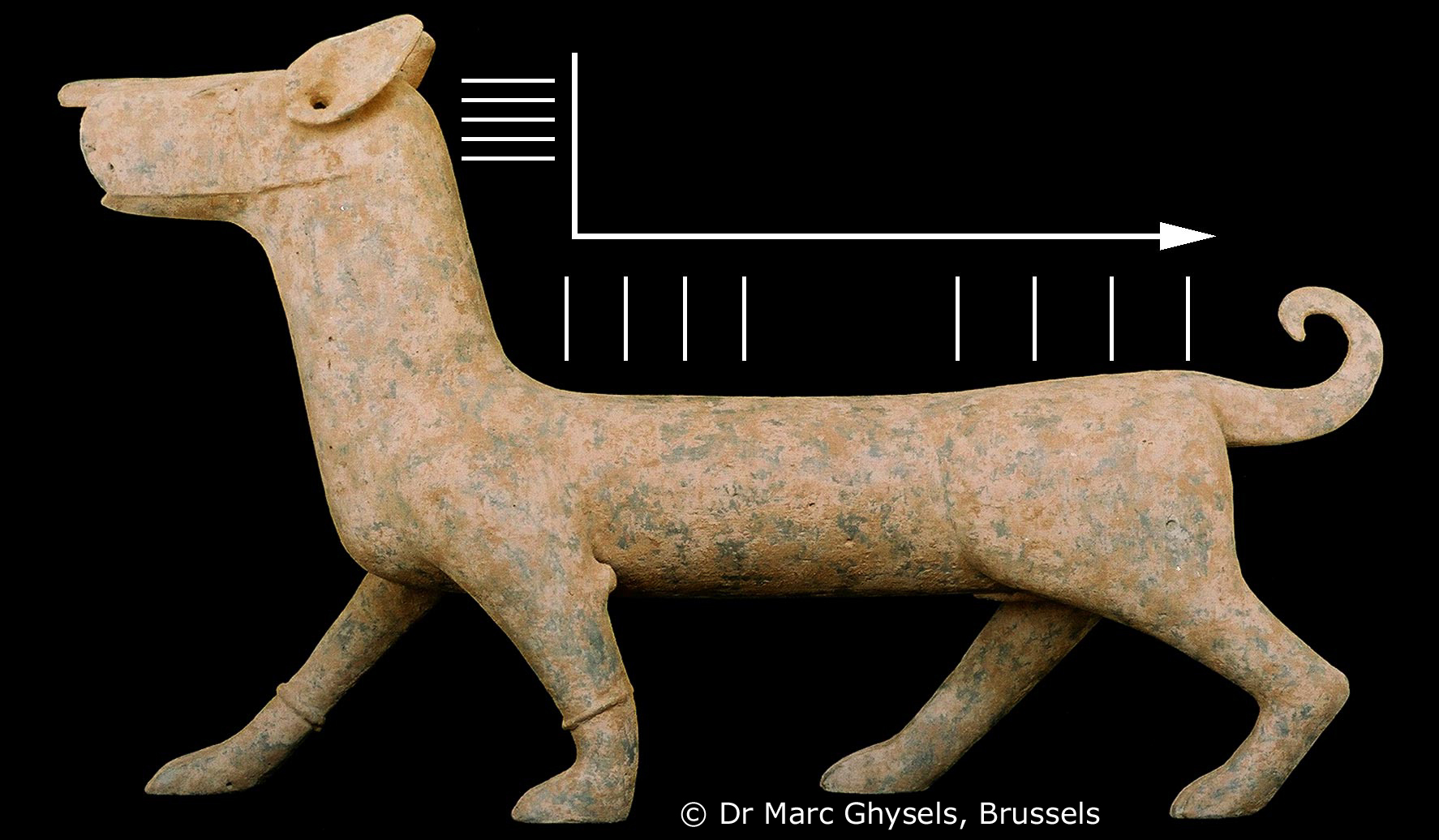
In an attempt to acquaint collectors with the amount of restoration
that commonly is found in antiquities, some acceptable and and usual, some
(all too much) completely unacceptable and fraudulent. We have started
with examples from China--an unacceptable pastische and an acceptable restoration--and
an outright fraud from Nigeria.
New example (4/8/04): a Han dog made of slices of ancient architectural brick. Click here to view.

Case 1: A tale of two horses
We often have problems judging where to take samples, since many objects
are pastiches or have been restored with replacement material of various
ages, and in some cases the object may turn out to be constructed in large
part or in entirety with a mixture of powdered pottery and an adhesive.
We offer this gallery of photos in an attempt to give you an idea of what
may lie beneath the skin of a typical T'ang unglazed horse. We are
working on getting permission to use photographs of some other sorts
of object.
The first exhibits are from a conscientious dealer who takes justifiable pride in the quality of his restoration work. He removes all previous surface restoration if not up to his high standard and re-restores the object. He fortunately takes photos and notes of the process.
The following photos dating from 1998 show an unassuming T'ang unglazed horse with saddle. It had been damaged in transit from Hong Kong, resulting in the head and legs breaking away from the body. There were glue joints on the legs (note: most T'ang standing horses and camels will have repair to the legs since they are so fragile, and we hear that they are often intentionally broken to make them more compact, for the midnight journey from China into Hong Kong under a load of vegetables). The surface was primarily chalky white material with considerable amounts of clay covering both outside and inside of the body. The horse as received is shown below.
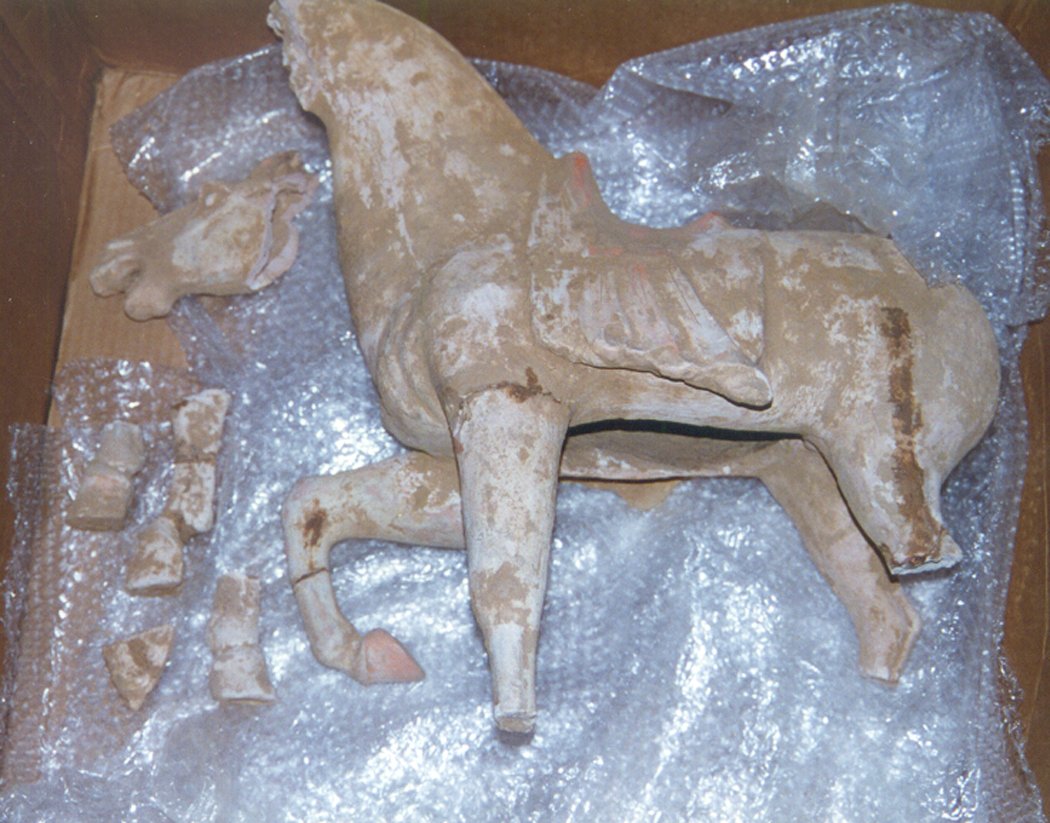
The piece was soaked in water to initiate breakdown of the surface material. The clay and white covering came off readily. Several portions of the neck and body were made up of plaster and several other portions were modeled from unfired clay. This latter quickly softened and washed away. Upon evaluation it was determined that the fired clay pieces appeared to be authentic, but that the animal was made up from three different horse bodies which were similar in size and shape. The next two photos show views of the naked horse.
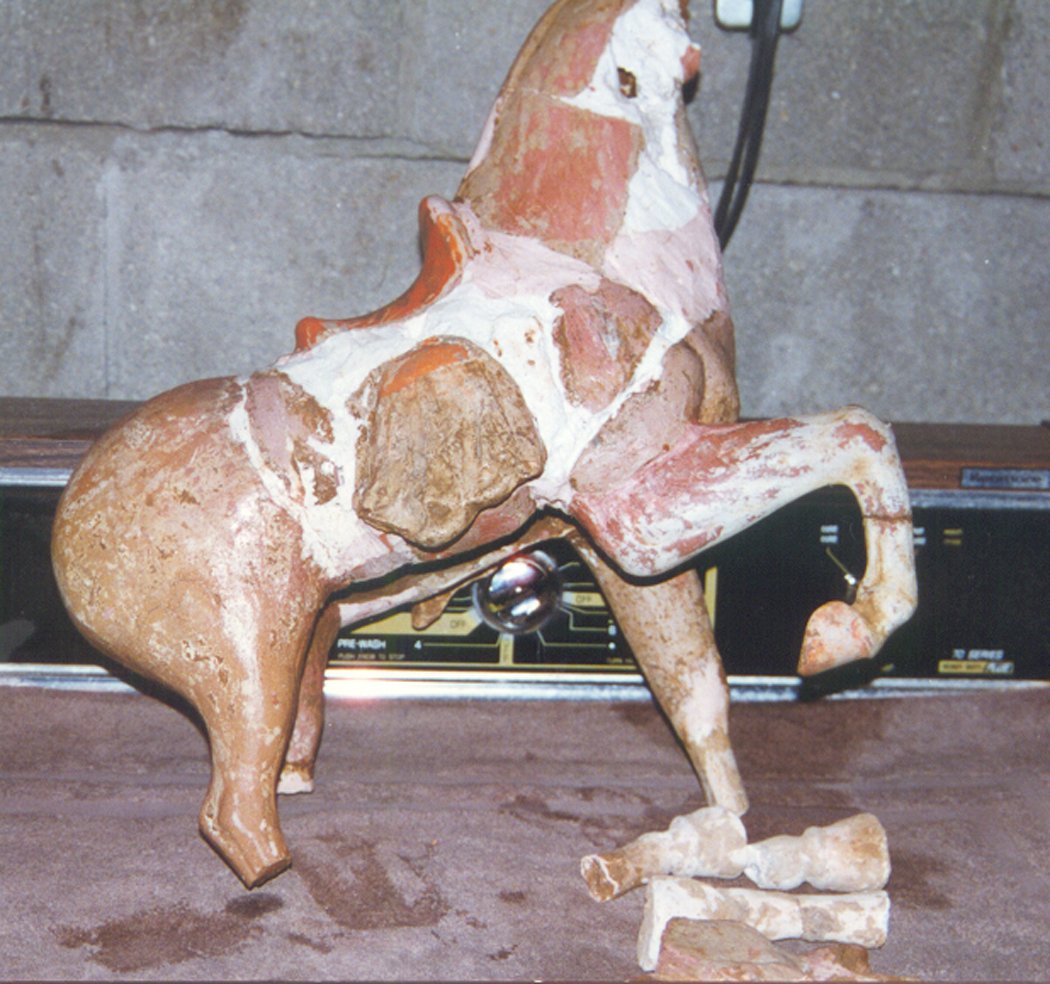
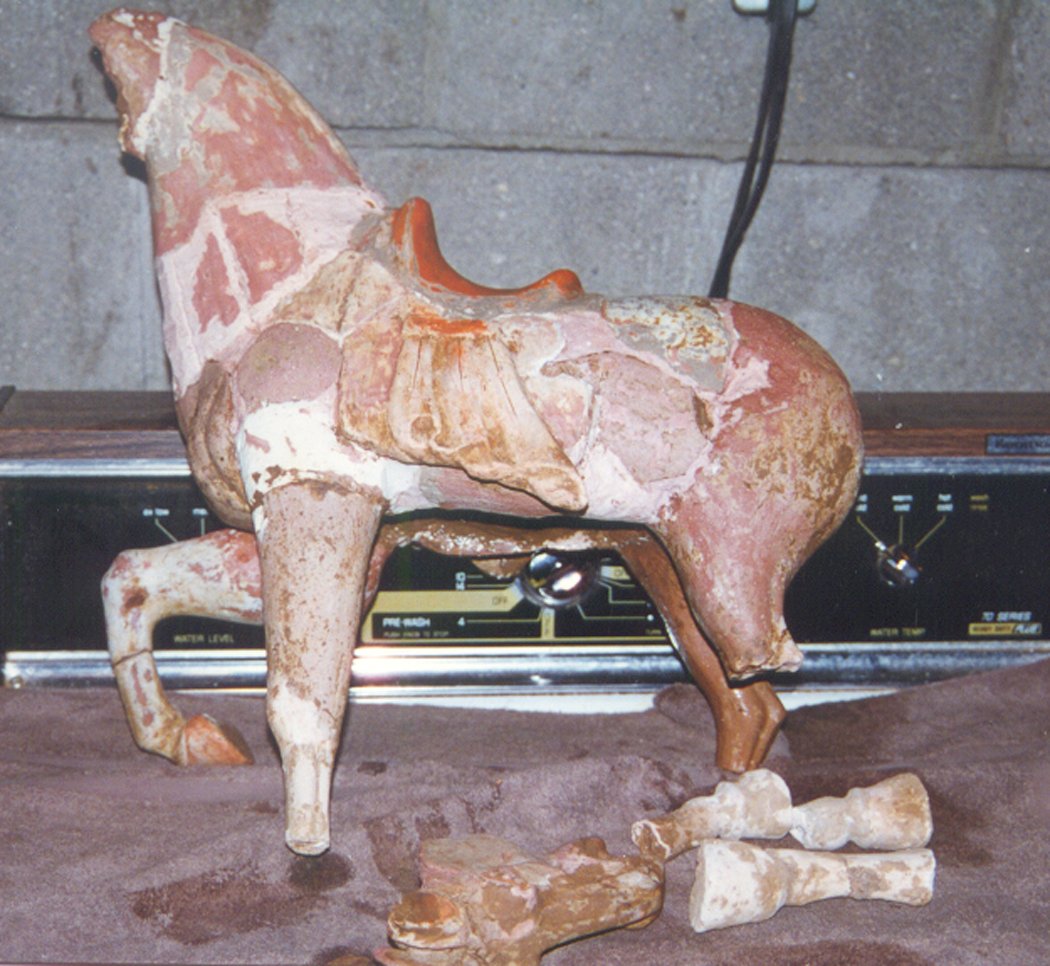
The dealer's interest having been piqued, he was curious whether the component fragments actually were old. Daybreak took two samples: one from the neck--a soft grayish clay, and one from the hindquarter--a sandy pink clay. The gray portion proved to be modern, with very different TL characteristics from the usual Chinese gray clay. This area was probably made for this horse during restoration in lieu of a suitable old fragment. The pink portion, however, yielded a TL age of 1350 +/- 230 years.
This type of reconstruction is the major reason for taking multiple
samples. We usually make several spot checks removing a tiny area
of the surface to check the color and texture of the clay all over an object
to get a feeling for the presence of replacement material. Heavily
restored Chinese material very often has a completely new surface to hide
repair, so we are essentially blind. The problem also is the reason
why results from two TL laboratories may differ when samples are not taken
from the same spots.
A TIP:
Most T'ang horses and camels, having a good-sized belly cavity are quite
clean inside; this is true as well as other objects with easy access to
the interior. If full of soil, or having a thin smooth layer of mud
inside, it is more than likely to be hiding extensive restoration.
If the actual pottery is clearly seen inside it is much easier to spot
restoration, and sample accordingly. We also have seen objects with
dirt on the outside and squeaky clean inside--these usually prove to be
fraudulent.
ANOTHER EXAMPLE: This horse is a happier case. Its condition as received is shown below:
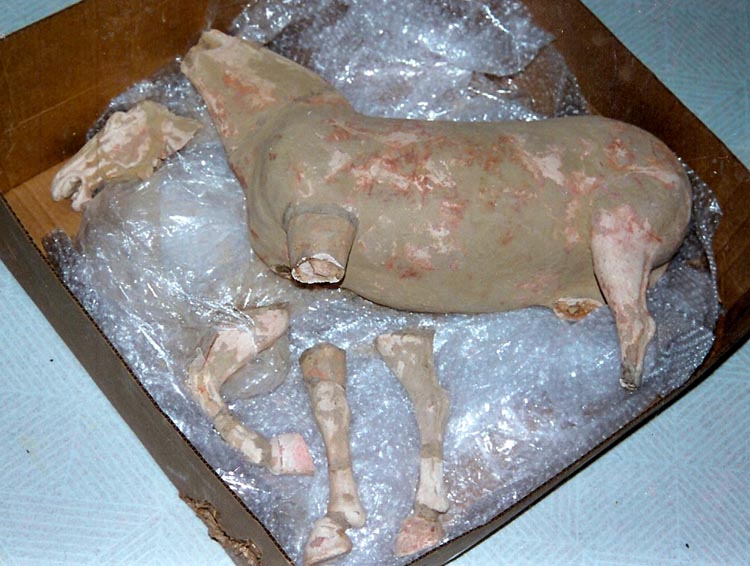
The horse was similarly treated to remove the surface repair. There were several missing fragments filled in, and some that appeared to belong to the horse, but overcleaned, resulting in loss of part of the fragile deep red post-firing pigment. This horse is quite large and was crushed, presumably in a roof cave-in, but most of it was recovered.
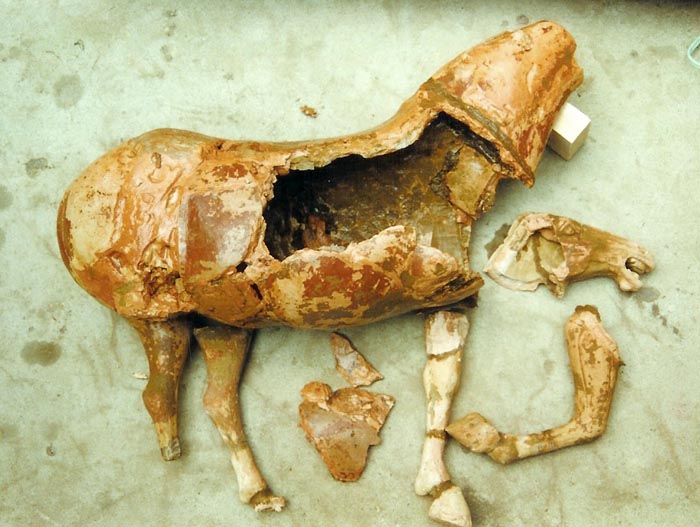
It then was completely disassembled into pieces for re-restoration.
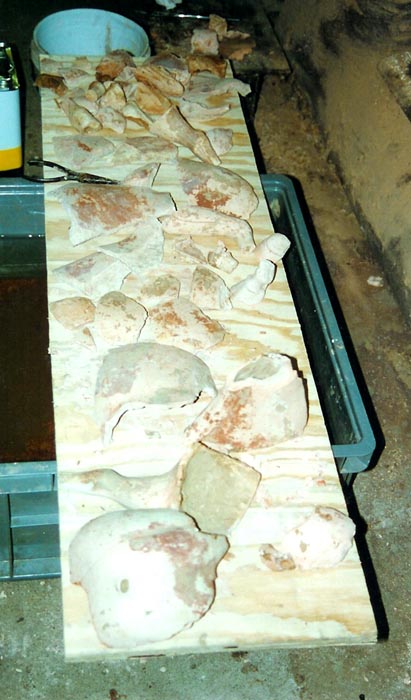
The state before any surface restoration is as below
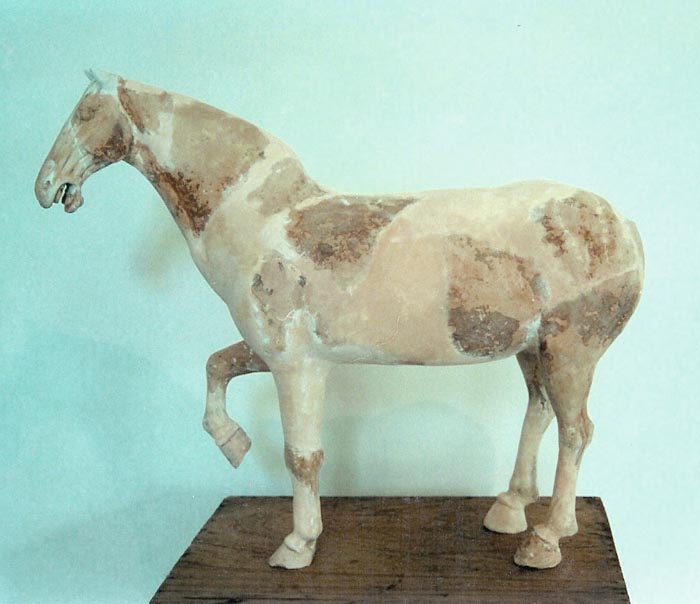
and the final result, a very nice and appropriate restoration.
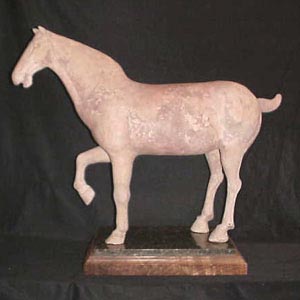
The final surface treatment was a mild blending ,just enough to remove
the distraction. Many objects are similarly restored, but some have
more surface treatment, often to the extent that the differences in color
are completely obscured. Buyers should never be led to believe that
such an object is actually intact. The extent of surface restoration,
as is the extent of replacement of missing portions, is a matter of taste.
There is no set standard, but Chinese and New World objects are almost
always completely restored to an almost like-new condition (but ancient-looking
surface), while some African objects are left nearly as found. The
other African objects are usually vastly over-restored.
This horse came fairly complete, but as you have seen, hardly intact.
Some of the best dealers in Chinese antiquities are so concerned about
problems hidden by restoration that they endeavor to obtain objects in
the as-excavated state and may not know just what they have until they
wash the soil off the fragments. But they then can be confident that
they know the true pre-restoration state.
Case 2: An 'Ife' head
The market has in the past several years seen a large number of previously unknown Ife heads and partial figures. Almost invariably they are fraudulent. Whereas earlier the fakes showed a recent TL date, in the past five years or so we have been seeing mostly objects reconstituted out of old pottery with a binder. Sometimes one of these heads incorporates the bottom and footring of a pot as a hat and/or the neck of a vessel, or fragments, as the neck of the head. The middle--the head proper--in made from pottery powder. The first ones we saw generally showed a TL date much too old, being fabricated out of Nok/Sokoto fragments, but now age-appropriate pottery sherds are used, and other means beside TL are helpful in catching these fakes. While we use various screening techniques that can quickly detect the binders, the following pictures show the situation very graphically. A photo of a small Ife-style head , typical of what is seen offered for sale by African traders, is shown first.
A special high-energy CT scanner (not like the medical CT scanners you are probably familiar with) at the Fraunhofer Institut at the University of Koblenz in Germany made a 3-D density image of the head. A rather large (14Mb) videoclip shows successive vertical slices through the head. Get it here. The difference in density is clearly seen. There are fragments of pottery inside serving as a base to model the object.
A static view of the central slice is shown in the image shown here. The metal tube for the mount shows bright (high density) in the center. Interestingly there appears to be a face in miniature on the fragment in front.
Fortunately, it isn't often necessary to go to the expense of CT scanning,
as the binder is detectable, but the images are arresting. Many thanks
to Lab. Ralf Kotalla and the Fraunhofer Institut for the use of these images
and the videoclip.
We intend to bring other cases to your attention when they become available.